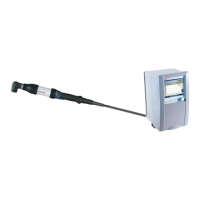3 608 878 300 Tightening Technology | Bosch Rexroth AG 327/641
System 350 | 3 608 878 300/2019-03
6.6.4 Mode of operation of the ToolsNet gateway
When the ToolsNet service is started, the configuration file is read.
A TCP/IP connection to the ToolsNet server is established for every configured station; the respective
tightening station is registered with system number, system name, station number, and station name.
Thereafter, they appear in the stations tree in the OP Undefined folder of ToolsNet.
Figure 10: Stations in ToolsNet
At the same time, the ToolsNet service opens the TCP/IP port (section [XML], parameter Port) defined in
the configuration file and waits until the tightening stations establish a TCP/IP connection and report
tightening results.
Once a tightening station has established a TCP/IP connection to the ToolsNet service, the system
checks whether its IP address is present in the configuration. If yes, the connection remains; if not, the
connection is closed. The assignment of the connected tightening station and the configured ToolsNet
station is achieved via the IP address.
Whenever tightening has been completed, the appropriate tightening station transmits the tightening
result to the ToolsNet gateway in the XML Protocol. If the syntax of the protocol is correct, the data are
extracted and buffered (section [Global], parameter File Queue Dir) as results file; the tightening station
receives a positive confirmation. In the event of job log file errors, the tightening results are discarded and
the tightening station receives a negative confirmation.
Provided the connection to the ToolsNet server has been established, the buffered results files are
transmitted to the ToolsNet server and then deleted after a positive confirmation has been received.
When the ToolsNet service is started, the buffered results files are read and transmitted to the ToolsNet
server.
To prevent data losses, the hard drive space available on the PC with the ToolsNet service and the
ToolsNet server should be as large as possible.
At the same time, the number of files per tightening station should be limited accordingly in the
configuration file (section [Global], parameter Max File Queue Size).
The ToolsNet service creates a daily logging file named XMLToolsNetGW.YYMMDD.log in the directory
specified in the configuration file (section [Global], parameter Log Path). The logging file serve to analyze
the processes in the event of an error. The logging files are automatically deleted after the configured
retention period (section [Global], parameter Log Days) has elapsed.

